Range Rover Evoque: Quarter Panel
Removal
NOTES:
Within this procedure there are 2 different options depending on type of vehicle body and combination of replacement panels.
The quarter panel is manufactured from mild steel.
The rocker panel butt joint in option 2 must be MIG brazed due to the location of boron reinforcements.
The screw in studs/screws must be replaced with new items in the installation for option 2 of the quarter panel, and the threads into which they are located must be cleaned rigorously to remove old adhesive before assembly.
There is a NVH component around the fuel filler neck aperture on the RH side. If damaged, a new component will be required.
1. The quarter panel is replaced in conjunction with:
- Rear bumper cover
- Quarter glass
- Headliner
- Tailgate
- Moon roof
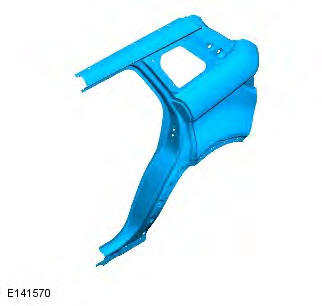
2. For additional information relating to this repair procedure please see the following: For additional information, refer to: Health and Safety Precautions (100-00 General Information, Description and Operation) / Body Repairs (501-25A Body Repairs - General Information, Description and Operation) / Corrosion Protection (501-25B Body Repairs - Corrosion Protection, Description and Operation) / Body and Frame (501-26 Body Repairs - Vehicle Specific Information and Tolerance Checks, Description and Operation) / Standard Workshop Practices (100-00 General Information, Description and Operation).
3. The Mechanical, Electrical and Trim (MET) listed below is for option 2, if the other option is selected then reduce MET strip as required.
4. NOTE: The roof panel is only removed for a combination of quarter panel and inner quarter panel and wheelhouse. Remove the roof panel.
For additional information, refer to: Roof Panel - Vehicles Without: Sliding Roof Opening Panel (501-28B Roof Sheet Metal Repairs - 5-Door, Removal and Installation).
5. NOTE: The moon roof is only removed for a combination of quarter panel and inner quarter panel and wheelhouse. Remove the moon roof.
For additional information, refer to: Glass Roof Panel (501-11 Glass, Frames and Mechanisms, Removal and Installation).
6. Remove the screw in studs/screws. Torque 13Nm.
7. Remove the rear bumper cover.
For additional information, refer to: Rear Bumper Cover (501-19 Bumpers, Removal and Installation).
8. Remove the liftgate.
For additional information, refer to: Liftgate (501-03 Body Closures, Removal and Installation).
9. Remove the side air curtain modules.
For additional information, refer to: Side Air Bag Module (501-20B Supplemental Restraint System, Removal and Installation).
10. Remove the rear quarter glass.
For additional information, refer to: Rear Quarter Window Glass - 5-Door (501-11 Glass, Frames and Mechanisms, Removal and Installation).
11. Remove the front seat.
For additional information, refer to: Front Seat (501-10 Seating, Removal and Installation).
12. Remove the floor console.
For additional information, refer to: Floor Console (501-12 Instrument Panel and Console, Removal and Installation).
13. Remove the rocker panel inner trim.
14. Remove the rear seat cushion.
For additional information, refer to: Rear Seat Cushion (501-10 Seating, Removal and Installation).
15. Remove the load space inner trim.
For additional information, refer to: Loadspace Trim Panel (501-05 Interior Trim and Ornamentation, Removal and Installation).
16. Release and lay aside carpet.
17. Remove the rear safety belt retractor.
For additional information, refer to: Rear Safety Belt Retractor (501-20A Safety Belt System, Removal and Installation).
18. Remove the front safety belt retractor.
For additional information, refer to: Front Safety Belt Retractor (501-20A Safety Belt System, Removal and Installation).
19. Remove the liftgate aperture weatherseal.
20. Remove the forced air extraction grille.
21. Remove the bumper cover upper guide.
22. Remove the rocker panel outer moulding.
23. Release and lay aside the wiring harness along the inner quarter panel and back panel.
24. Release and lay aside the insulating material at the inner quarter panel.
25. RH side: Drain the fuel tank.
For additional information, refer to: Fuel Tank Draining (310-00 Fuel System - General Information, General Procedures).
26. RH side: Remove the fuel tank filler pipe.
For additional information, refer to: Fuel Tank Filler Pipe (310-01A Fuel Tank and Lines - TD4 2.2L Diesel, Removal and Installation).
27. There are 2 options for the quarter panel installation depending on type of body and extent of damage.
28. CAUTION: Care should be taken not to cut through into the inner panels. Option 1. If the quarter panel is being installed in isolation cut the c-pillar as indicated.
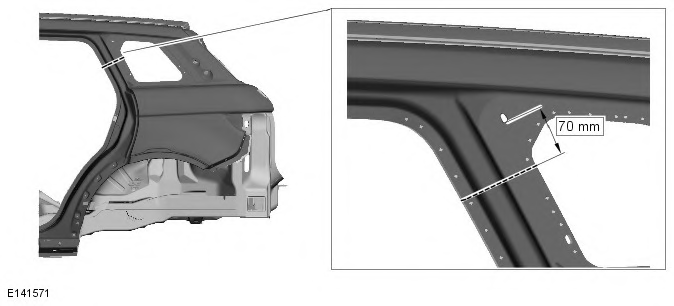
29. CAUTION: Care should be taken not to cut through into the inner panels. Option 1. If the quarter panel is being installed in isolation cut the d-pillar as indicated.
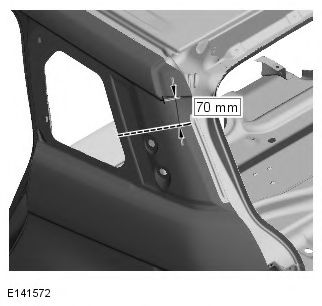
30. CAUTION: Care should be taken not to cut through into the inner panels.
NOTE: The moon roof/roof must be removed for this option
Option 2. If the quarter panel is being installed in a combination with the inner quarter panel and wheelhouse cut as indicated.
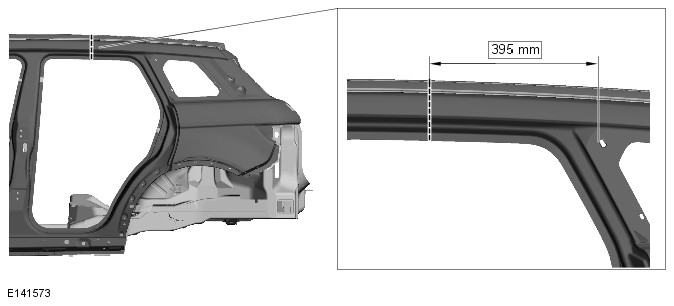
31. CAUTION: Care should be taken not to cut through into the inner panels. Option 1. Cut the quarter panel as indicated.
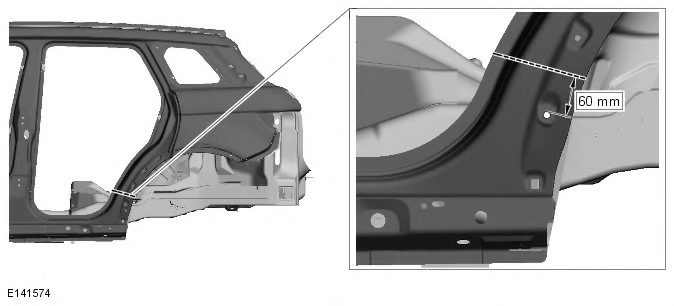
32. CAUTION: Care should be taken not to cut through into the inner panels. Option 2. Cut the rocker panel as indicated.
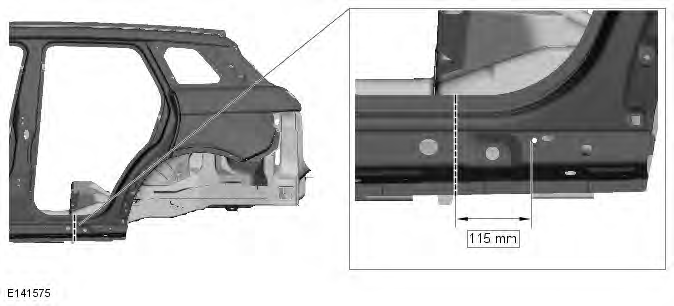
33. NOTE: This step is necessary to reveal hidden spot welds. This step is for option 2 only. Drill out spot welds, separate joint and fold up flange as indicated.
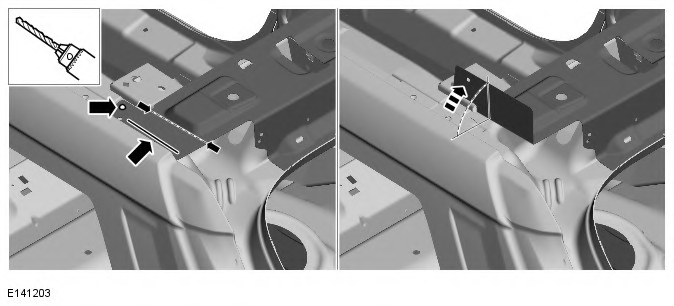
34. NOTE: Graphic shows option 2, for option 1 drill out spot welds as required. Drill out spot welds as indicated.
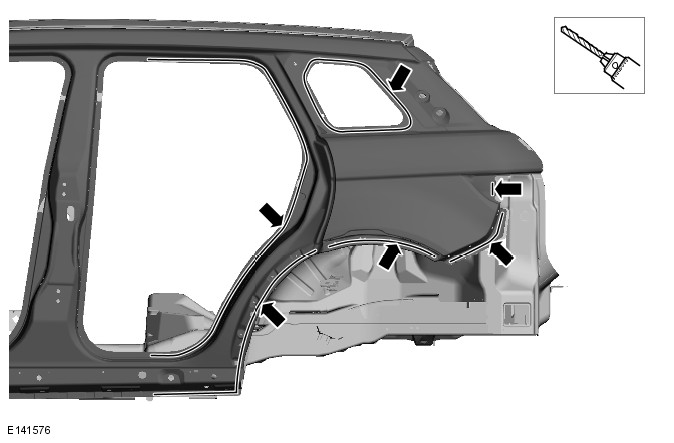
35. NOTE: Graphic shows option 2, for option 1 drill out spot welds as required. Drill out spot welds as indicated.
Make sure that any hidden spotwelds underneath the turned up flap mentioned in step 33 are also drilled out.
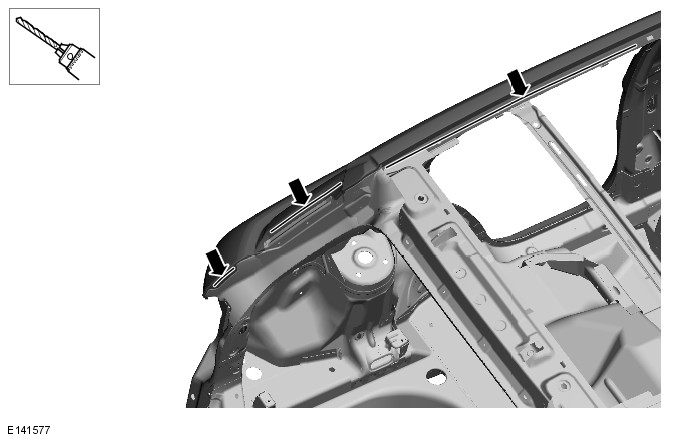
36. Separate the joints and remove the old panel, also releasing the NVH components from the old panel as indicated.
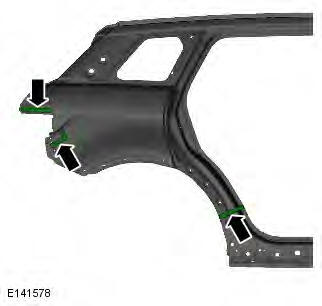
Installation
1. There are 2 options for the quarter panel installation depending on type of body and extent of damage.
2. Option 1. If the new quarter panel is being installed in isolation cut the c-pillar as indicated.
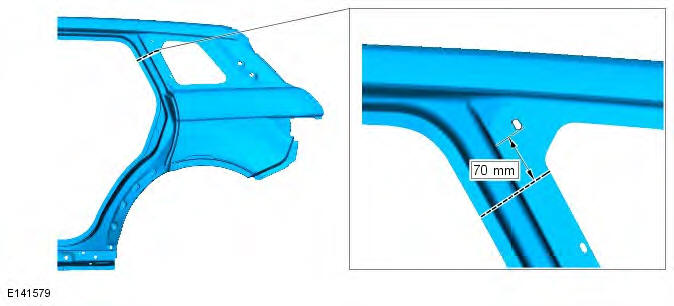
3. Option 1. If the new quarter panel is being installed in isolation cut the d-pillar as indicated.
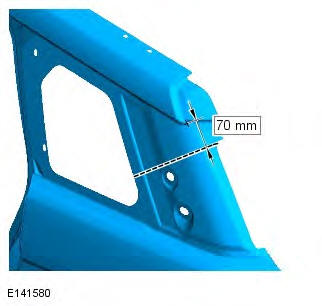
4. NOTE: The moon roof/roof must be removed for this option
Option 2. If the quarter panel is being installed in a combination with the inner quarter panel and wheelhouse cut as indicated.
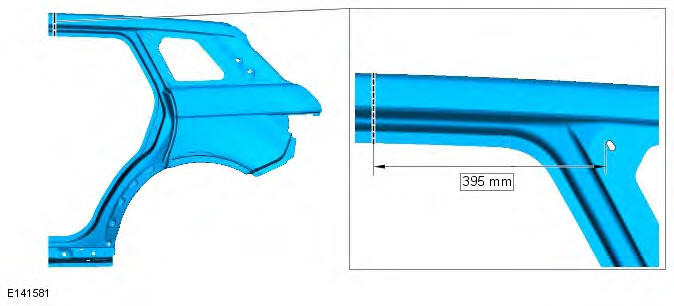
5. Option 1. Cut the quarter panel butt joint as indicated.
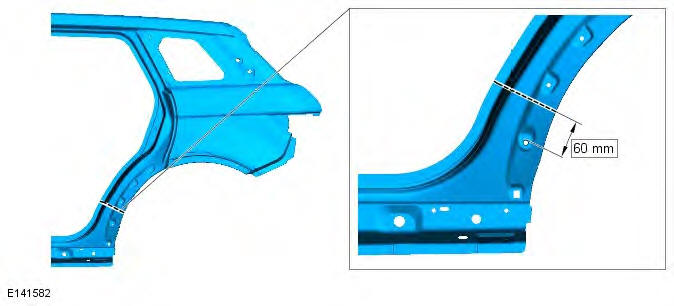
6. Option 2. Cut the rocker panel butt joint as indicated.
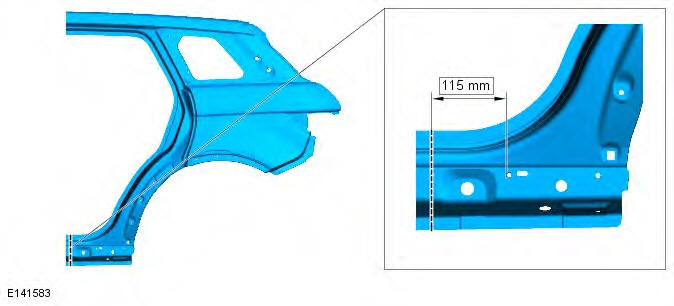
7. Prepare the old and new panel joint surfaces, including the NVH components.
8. NOTE: With panel in position check for access to spot weld the joints. Offer up the new panel and clamp into position. Check alignment, if correct, proceed to next step, if not, rectify and recheck before proceeding.
9. Remove the new panel.
10. Drill holes in new panel ready for MIG plug welding.
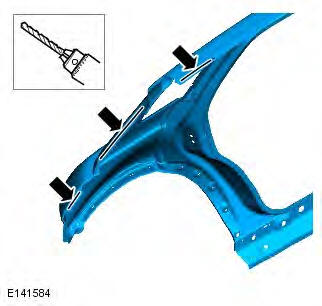
11. Deburr MIG plug locations in new panel.
12. NOTE: If spot welds are being installed in a joint that originally contained adhesive, the adhesive must be reinstated.
Apply panel bonding adhesive to spot welded/bonded areas as indicated. Use the bond path shown in the graphic as a guide, the panel bond adhesive must only be applied in the areas where spot welding is accessible for the installation of the new panel. It is not to be applied in any areas of MIG welding/brazing installation joints, leave a 30mm gap, so it does not affect the MIG weld/braze joint on installation.
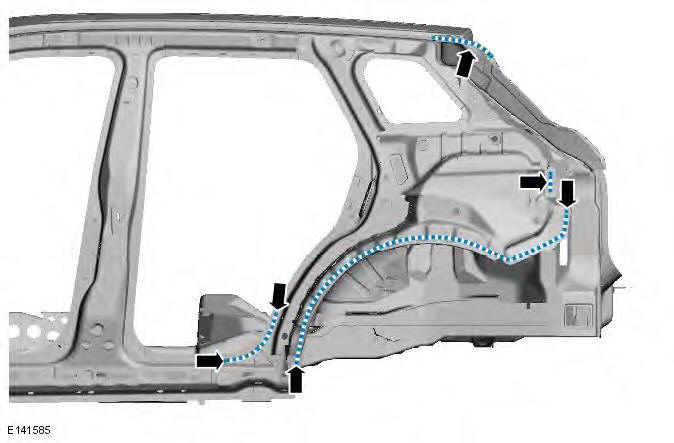
13. Apply sealer adhesive to the NVH components.
14. Offer up the new panel and clamp into position. Check alignment, if correct, proceed to next step, if not, rectify and recheck before proceeding.
15. Option 1. Tack MIG weld butt joints as indicated.
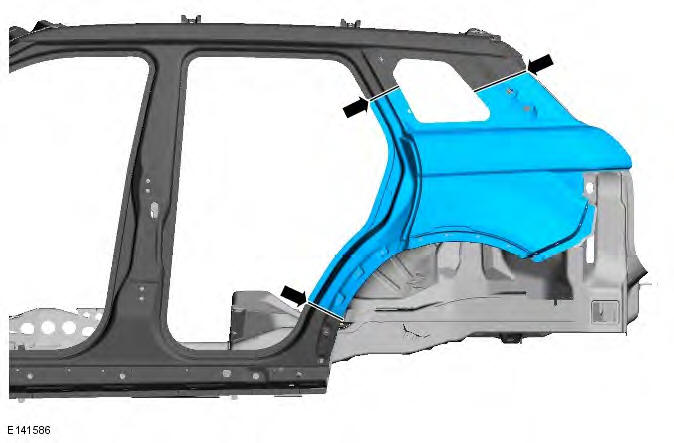
16. Option 2. Tack MIG weld the upper butt joint as indicated.
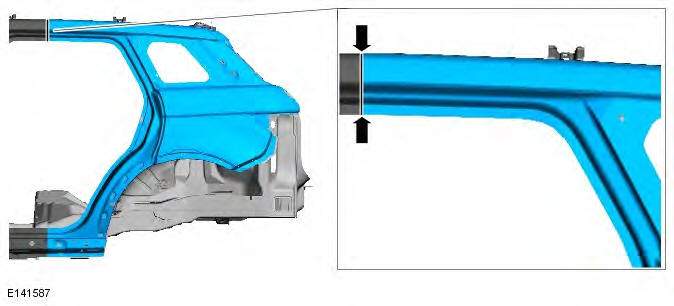
17. NOTE: These joints must be MIG brazed due to boron reinforcements. Option 2. Tack MIG braze the rocker panel butt joint.
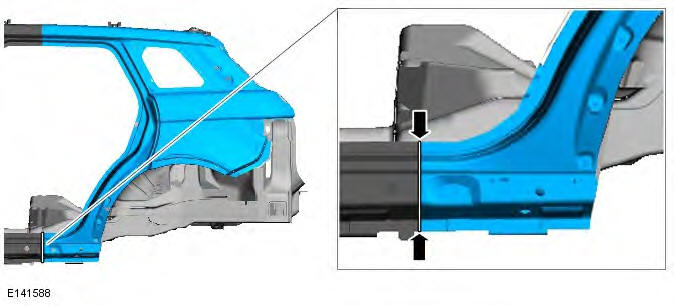
18. NOTE: Graphic shows option 2, for the option 1 spot weld where required. Spot weld.
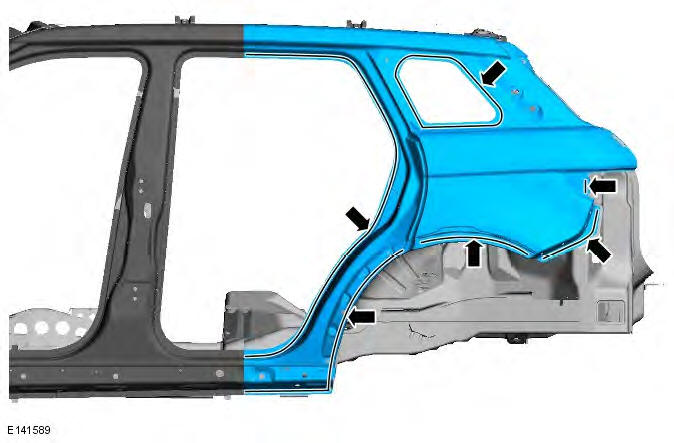
19. NOTE: Graphic shows option 2, for the option 1 spot weld where required. Spot weld.
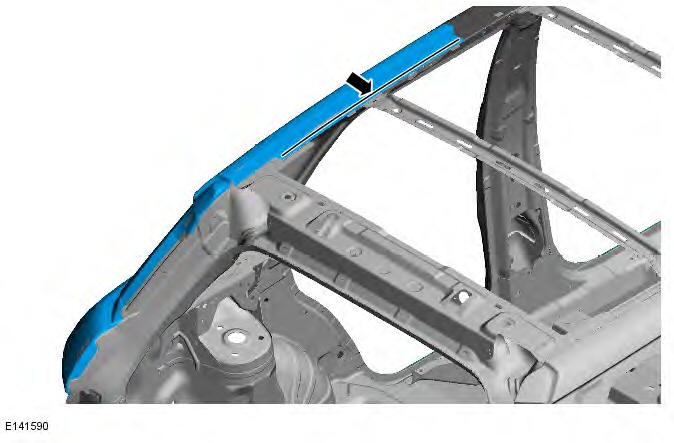
20. MIG plug weld where there is no access to spot weld.
21. NOTE: It may be necessary to dress some MIG plug welds to enable fitment of this flange. Realign rear roof flange and reinstall MIG plug welds.
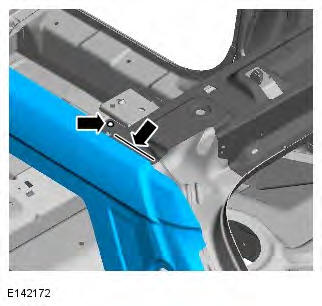
22. Option 1. MIG weld the butt joints as indicated.
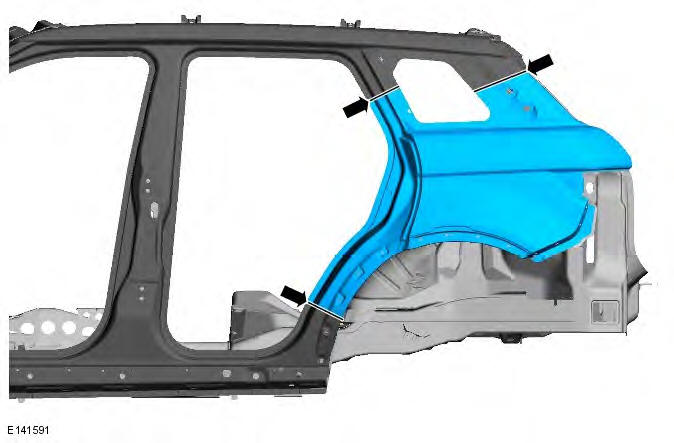
23. Option 2. MIG weld the upper butt joint as indicated
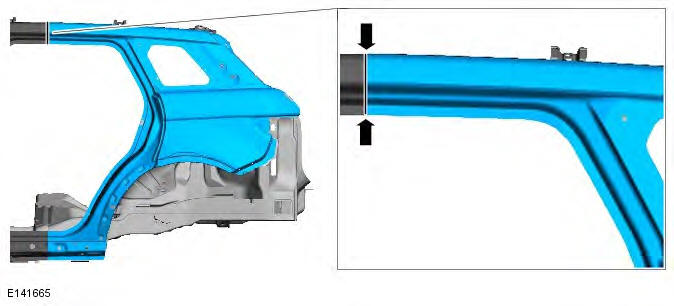
24. NOTE: These joints must be MIG brazed due to boron reinforcements. Option 2. MIG braze the rocker butt joint.
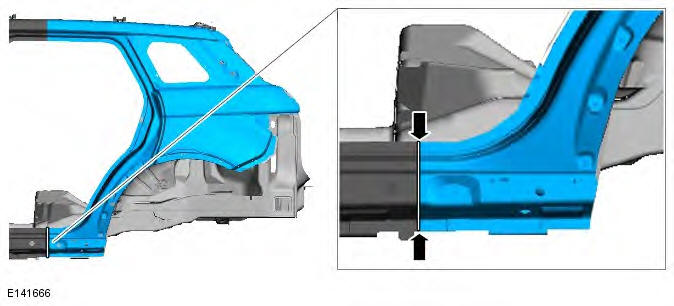
25. Dress all welds.
26. NOTE: Make sure all body joints are sealed following this repair procedure
The installation of associated panels and mechanical components is the reverse of removal.

